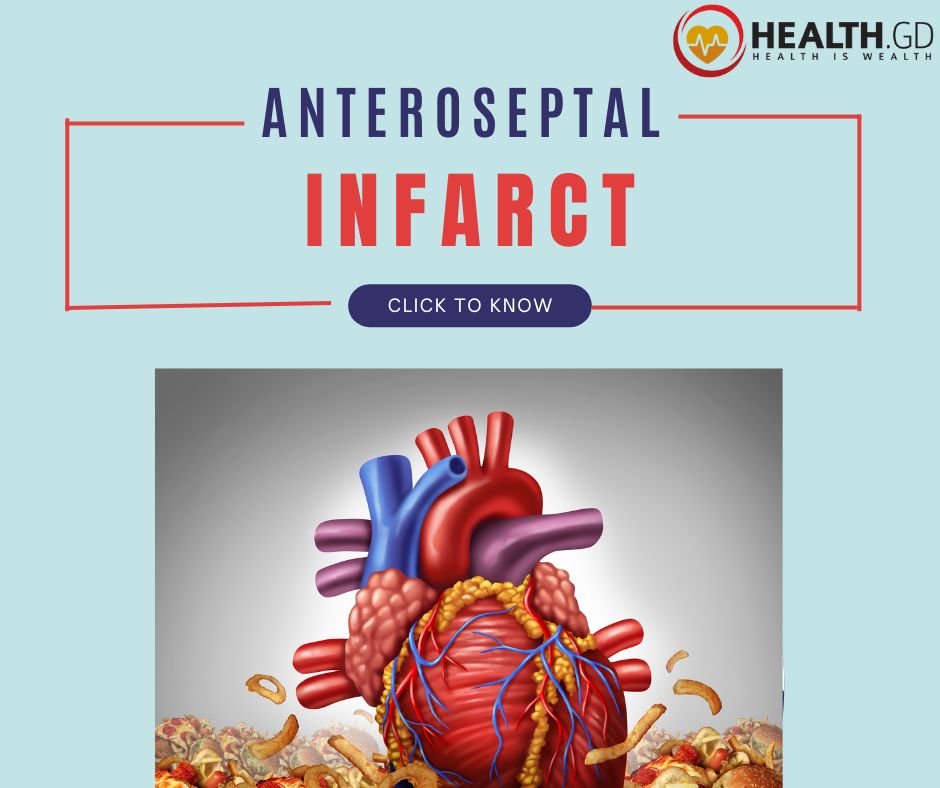Introduction

What causes Anteroseptal Infarct?
A very known cause of anteroseptal myocardial infarction is an unstable atherosclerotic plaque rupture that is found in the left anterior descending artery. An anteroseptal myocardial infarction diagnosis that is missed or delayed can result in substantial morbidity and mortality. This exercise focuses on the assessment and management of anteroseptal myocardial infarctions.
When a coronary artery occlusion prevents blood flow to the myocardium, three stages occur ischemia, damage, and infarction.
Some of the causes of blockage that result in ischemia, damage, and infarction are as follows:
- Thrombosis of the coronary arteries
- Coronary artery cramps are driven by factors such as cocaine usage
- Reduced coronary blood flow as a result of arrhythmias, pulmonary embolism, hypotension, or other causes
Which of the following leads is indicative of an anterior infarction?
When the left main coronary artery is obstructed, anterolateral infarctions develop, and changes appear in V5, V6, I, aVL, and rarely V4. A true anterior infarction does not affect the septum or lateral wall and causes abnormal Q waves or ST-segment elevation in leads V2-V4. AMI (occipital myocardial infarction) is a common heart illness with high mortality and morbidity and mortality associated. Acute anterolateral MI is distinguished by ST-segment elevation in leads I, aVL, and the precordial leads that overlap the anterior and lateral surfaces of the heart, indicating a favourable prognosis (V3 – V6). The bigger the ST elevation, the more severe the infarction.
Anteroseptal myocardial infarction (ASMI)
It is a term derived from electrocardiographic (EKG) data. The appearance of anteroseptal myocardial infarction is defined by EKG findings of Q waves or ST alterations in the precordial leads V1-V2. Most of the anterior basal septum was implicated in the infarction in individuals with an MI with ECG abnormalities in V1-V2 or V3, or V4. Until recently, this terminology was in use.
Furthermore, more recent research employs echocardiography and cardiac magnetic resonance imaging in MI patients with ECG alterations on V1 and V2. The anterior basal septum is seldom affected, but the apical and anthropical myocardial segments are most commonly involved.
Anterior-wall
ST-segment elevation MI (STEMI), the most frequent kind of MI, is classified as anterior-wall MI. These typically start in the subendocardium, with the highest oxygen demand and the least blood supply. The infarction spreads until it reaches the whole thickness of the myocardium; myocardial necrosis is frequently complete.
Determining MI
The World Health Organisation defines MI using three criteria: a patient history of severe, continuous chest pain, unmistakable electrocardiogram (ECG) alterations that include aberrant and persistent Q waves, and changes in serial cardiac biomarker levels that suggest myocardial damage and infarction.
Signs and Symptoms of Anteroseptal Infarct
Because the risk of mortality from an anterior-wall MI is greatest in the first 24 to 48 hours after symptoms appear, prompt identification and treatment are crucial for preserving myocardial function and avoiding sequelae. The first symptom is generally deep, substernal, visceral discomfort that extends to the back, jaw, left side of the neck, or left arm as aching or pressure. MI can happen at any time of day, although it usually happens within 3 hours after waking up, and the pain lasts for 30 minutes or longer. Other indications and symptoms include,
Chilly pallid skin, diaphoretic dyspnea, or orthopnea epigastric pain with nausea and vomiting, weariness, and cognitive function impairment. Furthermore, Palpitations, peripheral or central cyanosis, restlessness, fear, syncope, or near-syncope are all symptoms of Levine’s sign (clenched fist held over the sternum), etc.
Different indications and symptoms may be experienced by women, diabetics, African Americans, and the elderly. Common indications and symptoms in women include unusual exhaustion, sleep disruptions, shortness of breath, dyspepsia, and anxiety. Pain or discomfort, stiffness, strain, sharpening, scorching, swelling, or buzzing are all possible symptoms of chest pain in women. Women may also feel fatigued, chilly sweats, dizziness, back or upper chest pain or discomfort, pain or discomfort in one or both arms, an abnormal heart rate, and nausea.
Treatment of Anteroseptal Infarct
Treatment aims in MI include acute ischemia alleviation, avoidance of MI development and mortality and the emphasis is on early diagnosis, pain treatment, the commencement of antiplatelet medication, intravenous anticoagulation, and the restoration of early reperfusion.
Moreover, early reperfusion is critical in the case of STEMI to prevent tissue death and life-threatening oscillations and to increase survival and lengthy morbidity.
During the first 24 hours, the dr should begin oral beta-blocker medication. Oral beta-blocker medication should have started during the first 24 hours in patients with no contraindications, such as a low output condition, cardiogenic shock, decompensated heart failure, or an active heart block. In individuals with a contraindication to beta-blocker usage with continuing or recurrent ischemia pain, a non-dihydropyridine calcium channel blocker such as diltiazem as the first treatment may be an alternative. All patients should be given high-dose statin medication.
A beta blocker, i.e., metoprolol or carvedilol, should be given to the patient within 24 hours after the commencement of MI symptoms. Cardiac arrest, a lower power condition, an increased risk of cardiogenic shock, heart block, and active asthma are all limitations to beta-blocker usage. Beta-blocker treatment will be continued after discharge for prevention as it reduces mortality after MI by thirty per cent.
Conclusion
Angiotensin-converting enzyme (ACE) inhibitors,i.e., enalapril and captopril, lower mortality risk in patients with anterior-wall MIs when taken orally during the first 24 hours following ST-segment elevation. These medications should ideally be administered after fibrinolytic therapy has been completed, and blood pressure has been normalised. ACE medications minimise afterload by minimising heart effort and the ventricular remodelling that occurs with MI.